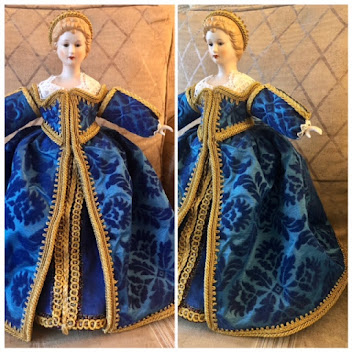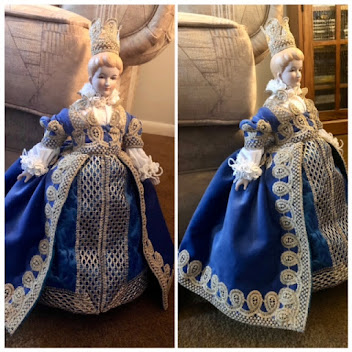Linen used was 32 threads per inch 100% linen fabric. I found the finest from a local cross stitch shop, as it would be easier for me to see in person the thickness I am purchasing. This was edged to prevent fraying and then stitched to a wooden frame for the lacework to be completed. Keeping in mind the tension needed consistency which was a challenge during this part of the project.
The side vertical channels of the design are 14 threads across with 6 on either side of 2 in the middle. The middle vertical channel is 20 threads across with 9 on either side of 2 in the the middle. The bottom horizontal channel is 40 threads across with 18 on the top and 19 on the bottom and 3 in the middle.
In cases of direction, weft threads were cut for the horizontal channel and warp threads stitched into cross sections. Where as the vertical channels the warp threads were cut and the weft were gathered into cross sections stitched into place.
A knowledge of weaving for the direction of the fabric plus and knowing which threads to cut in which direction was very important for the project to remain organized. Luckily the design is geometric and makes the formula easier to figure out.
All the pulled threads counted 6 threads to make vertical cross sections for the horizontal channel at the bottom of the design. Then gathered the same number for weft threads in the vertical channels. I used a buttonhole stitch to secure around all the channels and also as the stitch to gather all the cross sections.
 Letting some space for the foundation threads that would be later sewn with button hole stitch to meet the same thickness as the cross-sectioned threads. You can see the cross-sectioned areas are thicker in the adjacent photo. Foundation threads are thinner ready to be worked with the buttonhole stitch to give depth as well as attach to intersecting lines for stability and strength.
Letting some space for the foundation threads that would be later sewn with button hole stitch to meet the same thickness as the cross-sectioned threads. You can see the cross-sectioned areas are thicker in the adjacent photo. Foundation threads are thinner ready to be worked with the buttonhole stitch to give depth as well as attach to intersecting lines for stability and strength.
One of my major challenges is preventing twisting in the buttonhole stitches around the base threads on either the cross-sections or the foundation threads. This is where tension and consistency plays a role in the look remaining fluid through the whole design. I discovered this later in the making of this project and would much different than if I had known a little more technique at the beginning.
Though as I began to realize I found ways of undoing the twist or making it work to more dramatic effect. So on occasion happy little discoveries can be made during the creation process.
I am certain this happens to many an artist in their work.
Fig 22
 In this adjacent photo we have the first cross-sectioned piece all filled in with foundation threads all stitched and intersections secured. This is really where I could see all the potential of the design working into the final look.
In this adjacent photo we have the first cross-sectioned piece all filled in with foundation threads all stitched and intersections secured. This is really where I could see all the potential of the design working into the final look.
Till this point I was considering starting over and considering other options for this feature of the doll. Though I knew this was the centerpiece and everything was working up to this point and the apron had to be handmade lace. It may not be the best piece of lace but its my first piece and though its not as exact as I would like am very proud about not giving up and completing the task.
In the end its not always the most perfect piece that tells us an exciting story. Instead the one that needs some work or is a beginner piece that states the character of the creator of the art. The adjacent picture shows the first circle loop completed is the center of the design and gives it some extra geometric character to the linear for the horizontal channel. There is more circle motifs in the vertical channels as well to create a solid unity of design.
All the buttonhole is worked in a fine 2/100 silk thread from white wolf and phoenix and is just great for this kind of fine work. Beeswax of course to prevent fraying and tangling. I also used a wider white silk for edging and finishing for this piece.
In the images below from left to right I show the process of lining out the channel, snipping/pulling, them bordering the channels, and stitching cross=sections then adding sterling silver jump rings to make smaller circles for the upper channels.
The over all design is representative of the lace apron in the painting but a few changes of design due to unrefined skill level abilities though a strong first attempt at pulled lace embroidery.
























